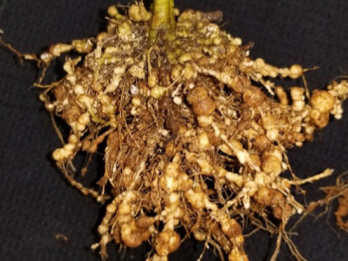Guava root-knot nematode
Guava root-knot nematode (Meloidogyne enterolobii) is a microscopic roundworm that parasitises the roots of crops. Despite its common name, GRKN has a broad host range.
Background
Guava root-knot nematode (GRKN) is found in tropical to subtropical areas of the world, including USA and South America, Africa, Asia, and some European countries in greenhouse settings. It has also been detected in Queensland and the Northern Territory.
As with all root-knot nematode species, GRKN is easily transmitted with soil and plant material. They are most likely introduced to new areas through:
- infested soil and growing media
- plants for transplanting
- bulbs
- edible tubers from sites where GRKN occurs.
Other pathways for transmission are soil attached to machinery, tools, footwear, or plant products.
Impacts
GRKN affects many plants including chilli, coffee, cotton, ginger, guava, papaya, soybean and common bean, sweet potato, watermelon, tobacco, and ornamental plants.
The nematodes affect the plant’s ability to uptake nutrients or absorb water, which leaves it susceptible to secondary pathogens. This disrupts the plant growth and reduces crop yield.
Identification
The most noticeable symptom of GRKN is knots or galls on the roots of the plant. These are caused by the nematodes burrowing into the plant and reproducing, which results in thickened root tissue.
GRKN looks similar to water stress due to the damaged the root system, making it difficult to diagnose. Plants infected with GRKN often show:
- stunted growth with smaller leaves
- yellow and wilted leaves
- brown, black, or discoloured root tips
- smaller and increasingly fewer vegetables or fruits.
Underground crops, such as tubers, are directly affected as galls and knots reduce product quality. Inspect your crops for plants with poor vigour and check underground plant parts for the presence of galls.


